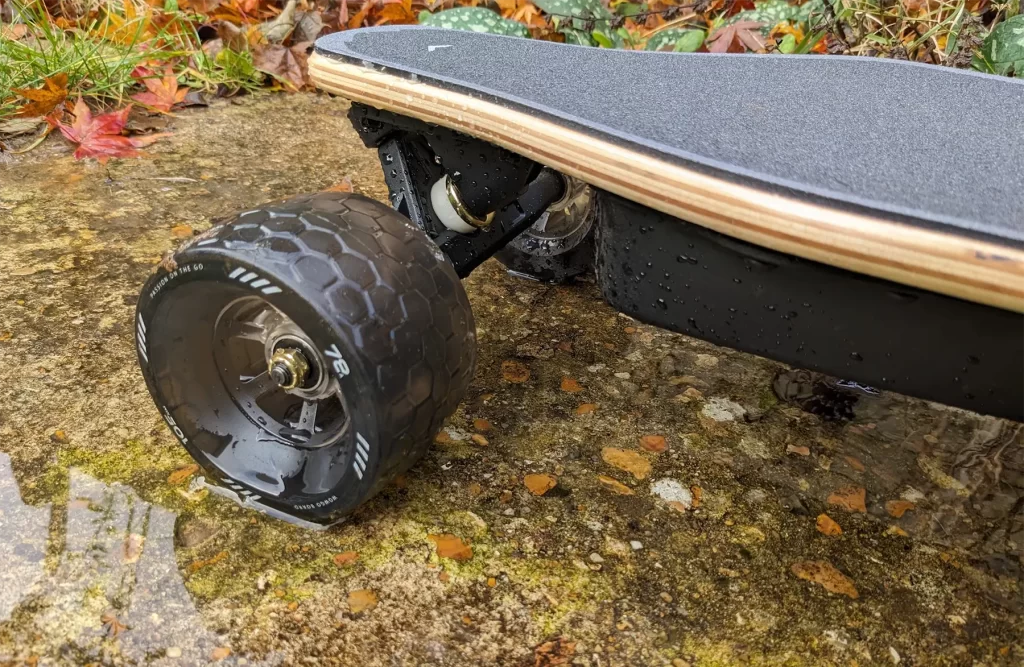Electric skateboarding, an exhilarating blend of technology and sport, has captivated enthusiasts worldwide. However, one question often lingers in the minds of riders: "Can you use electric skateboards in the rain?" This query brings forth a spectrum of opinions within the community.
On one hand, there's the lure of cruising through rain-splattered streets, a testament to the adventurous spirit of skateboarders. On the other hand, there are valid concerns about safety, board damage, and the impact of wet conditions on performance.
This blog post aims to navigate through these divided opinions, shedding light on the realities of riding electric skateboards in the rain. By delving into expert insights and user experiences, we'll explore the intersection where the thrill of the ride meets the caution demanded by the elements.

Riding an electric skateboard in the rain is indeed possible, but it comes with significant limitations and safety considerations.
When considering the allure of electric skateboarding in the rain, a pivotal question arises: "Are electric skateboards waterproof?" The answer is nuanced. While many manufacturers tout their skateboards as water-resistant, this claim often comes with significant caveats. The general design of electric skateboards is not inherently waterproof. Components like batteries, motors, and electronic controllers are susceptible to water damage, a vulnerability that rain and puddles eagerly exploit.
Diving deeper into the technical jargon, we encounter terms like 'IP65' – a common waterproof rating cited by manufacturers. This rating suggests protection against low-pressure water jets from any direction, but it's not an assurance of complete waterproofness. In the unpredictable and varied conditions of rainy roads, this rating's effectiveness is limited. A sudden puddle can compromise the integrity of the skateboard's battery box, potentially necessitating costly repairs or replacements. Thus, while some boards boast of high waterproof levels, their performance in wet conditions can be starkly different, underscoring the importance of understanding these limitations before venturing into the rain.
Riding electric skateboards in the rain isn't just about splashing through puddles – it's a venture fraught with risks. The most immediate danger lies in the potential damage to electrical components. Water can cause short circuits in batteries, motors, and controllers, leading to malfunctions or even permanent damage.
Traction is another critical concern. Standard polyurethane wheels, common on most electric skateboards, become treacherously slippery on wet surfaces. This loss of grip increases the risk of accidents, making it challenging to control the skateboard. However, the scenario is slightly more favorable for those with all-terrain electric skateboards equipped with rubber tires. These tires offer considerably better traction in wet conditions, providing a safer and more stable ride.
Braking issues are yet another hazard. Wet conditions can significantly impair braking effectiveness, leading to longer stopping distances and a higher risk of collisions. Anecdotes from the electric skateboarding community often recount experiences of unexpected skids and difficulty in maneuvering during rainy rides.
To mitigate the risks of water damage when riding an electric skateboard in the rain, a few precautionary measures can be taken:
By taking these steps, riders can significantly reduce the risk of water damage to their electric skateboards, ensuring a safer and more reliable experience even in damp conditions.
Safety should always be the top priority when venturing out on an electric skateboard in wet conditions. Here are some crucial safety considerations:
By adhering to these safety measures, you can significantly mitigate the risks associated with riding an electric skateboard in the rain.
Proper maintenance after a wet ride is crucial to prolonging the life of your electric skateboard:
Following these steps can help maintain the performance and safety of your electric skateboard, even after exposure to rain.
In the event that your electric skateboard gets heavily soaked, swift action is crucial:
Taking these steps promptly can help minimize water damage and keep your electric skateboard in good working condition.
In conclusion, while the thrill of riding an electric skateboard in the rain can be enticing, it's imperative to be aware of the risks involved. The potential for water damage to electrical components reduced traction and braking issues, and the heightened risk of accidents must be carefully considered. Adopting waterproofing measures, wearing appropriate safety gear, and performing regular maintenance can mitigate some risks, but not all. It is essential for riders to balance the excitement of rain riding with the possible costs and dangers. Ultimately, safety and long-term care of the skateboard should guide your decision to ride in wet conditions.
